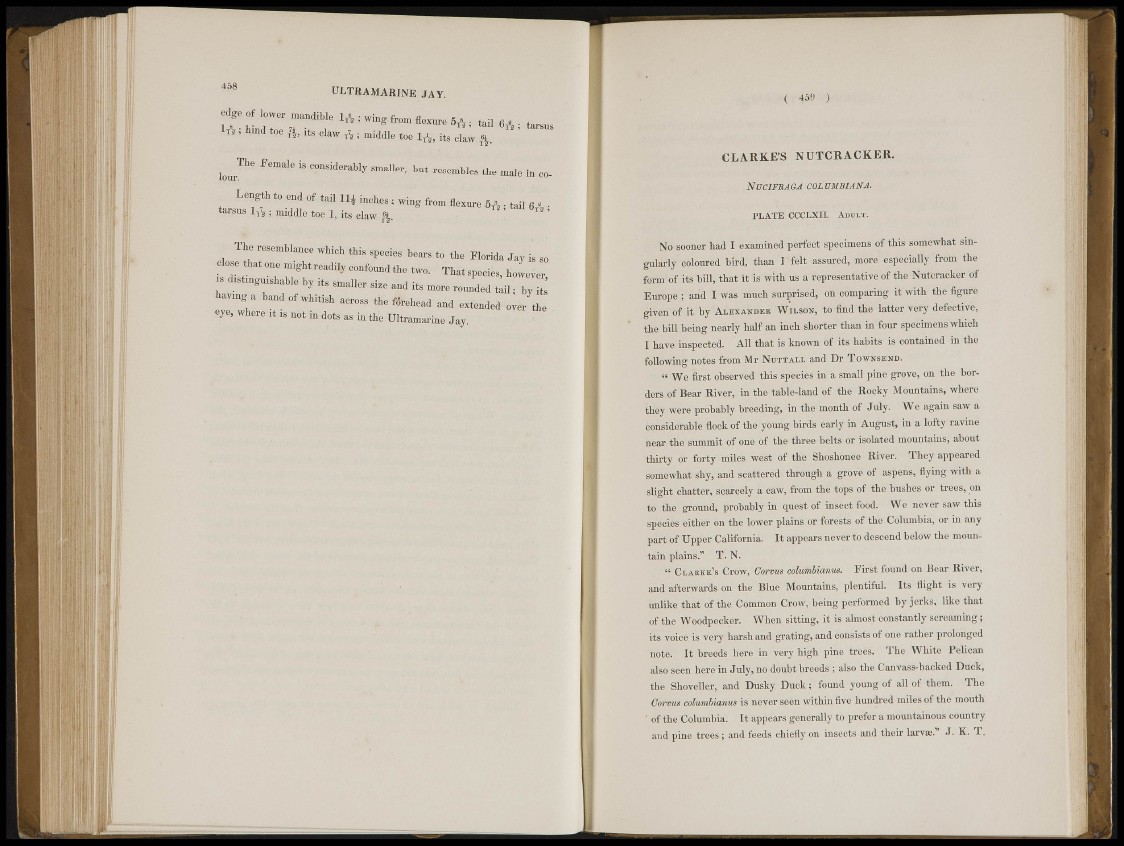
458
u l t r a m a r i n e jay.
B B I B I 1 1 1 ^ wingfrom flexure 5 A i tail • teus
i R d toe ft, I t s eUw A ; ^cHl e t o e ^ ife3 ^ ;
lo J ¥ ' *e m " 4 e Sm a J l e r ' ^ resembles.Wie male W
M l t 0 1 l M 1 • | fr°m tarsus 1,'s: middle too I, its claw ft. , tail 6A l
V The resemblance which this species b e ^ t to the Florida Jay is so
«lose i n t o n e might r e adi ^ confound the two. Thatsp'eeik, howe J
S distinguishable b 5 its smaller s f e and its more ro J d e d t ^ J S
haying a band pf whitish across the b e h e a d and exude d over the
eye, wh«e : l t iS nSt in dots as in the Wtratoarme Jay. •
( 45!» )
C L A R K E ' S NOTCHACKKR.
\VC1FBAC,A ROZ VMBIAN4-
P L A T E tX'Ol.XU. ADULT.
•No sooner had I examined perfect specimens of this somewhat singularly
coloured bird, than I'felt assured, more especially from the
form of its hilt, that it is with lis: » representative of the Nutcracker of
Kurope ; arid I was limch surprised, on comparing it with the figure
gif en of it1 by A L E X A N D E R w' I L S O X , to lind the latter very defective,
thè bill being nearly half * inch shorter than in four specimens which
I have: inspected. All that is known of its habits is contained in the
following notes from Mr N"I:TTAI.I. and Dr TOWNSEND.
" We first observed this species in a small pine grove, on the borders
of Bear River, in the table-land of the Rocky Mountains, where
they were probably breeding, in the month of July. We again saw a
considerable fiocklfS1 the young birds early in August, in a lofty ravine
near the summit of <®J ÔÎ t f e three bolts or isolated hiountains, about
thirty or forty miles west of the Shoshonee River. They appeared
somewhat shy, and scattered through a grove of aspens, flying with a
slight chatter, scarcely a caw, from the tops of the bushes or trees, on
to; the ground, probably in quest of insect food. We never saw this
Species either on the lower plains or forests of the Columbia, or in any
part of Upper California. It appears never to descend below the mountain
plains." T. N.
« CLARKE' S Crow, Omm cobMiemus. First found on Bear River,
and afterwards on the Blue .Mountains, plentiful. Its flight is very
unlike that of the Common Crow,: being performed by jerks, like that
of the Woodpecker. When sitting,, it feialmost constantly screaming ;
its voice is very harsh and grating, and consists of One rather prolonged
noté. It breeds hère in very high pine trees, ' The White Pelican
also seen here in July, no doubt breeds ; also the Canvass-backed Duck,
the Shoveller, and Dusky. Duck ; found young of all of them. The
Corns colimbianus is never seen within five hundred miles of the mouth
' of the Columbia. It appears generally to prefer a mountainous country
" and pine trees ; and feeds chiefly on insects and their larvoe." J. K. T.